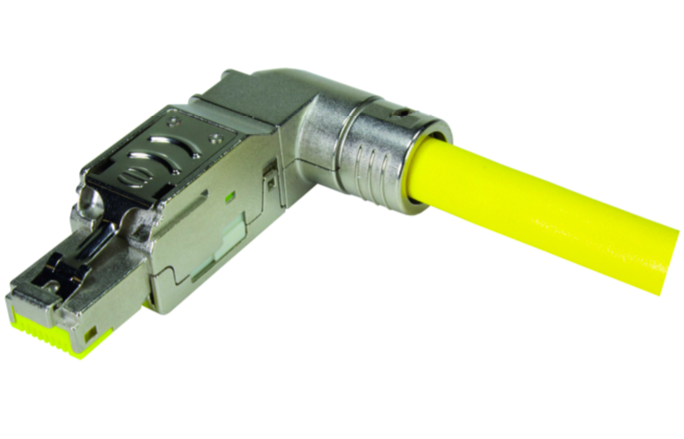Connectors Get Tough for Industrial Robots and Automation
As more robots and other connected devices join the factory floor, the challenge is to protect sensitive electronics from dirt, debris, vibration, and other barriers to performance.
As the Industrial Internet of Things (IIoT) continues to expand, it brings more electronic devices to the factory floor. There, they are exposed to harsh environments including dust, oil, liquids, and temperature extremes. At the same time, the number and types of industrial robots are increasing, especially as collaborative robots, or cobots, migrate onto the factory floor to help humans.
For example, new collaborative arc welding robots, introduced by FANUC in late 2019, provide higher payloads and a full six axes of motion for greater flexibility. This combination allows them to process a broad range of parts, while their small footprint and elimination of safety guarding equipment saves floor space.
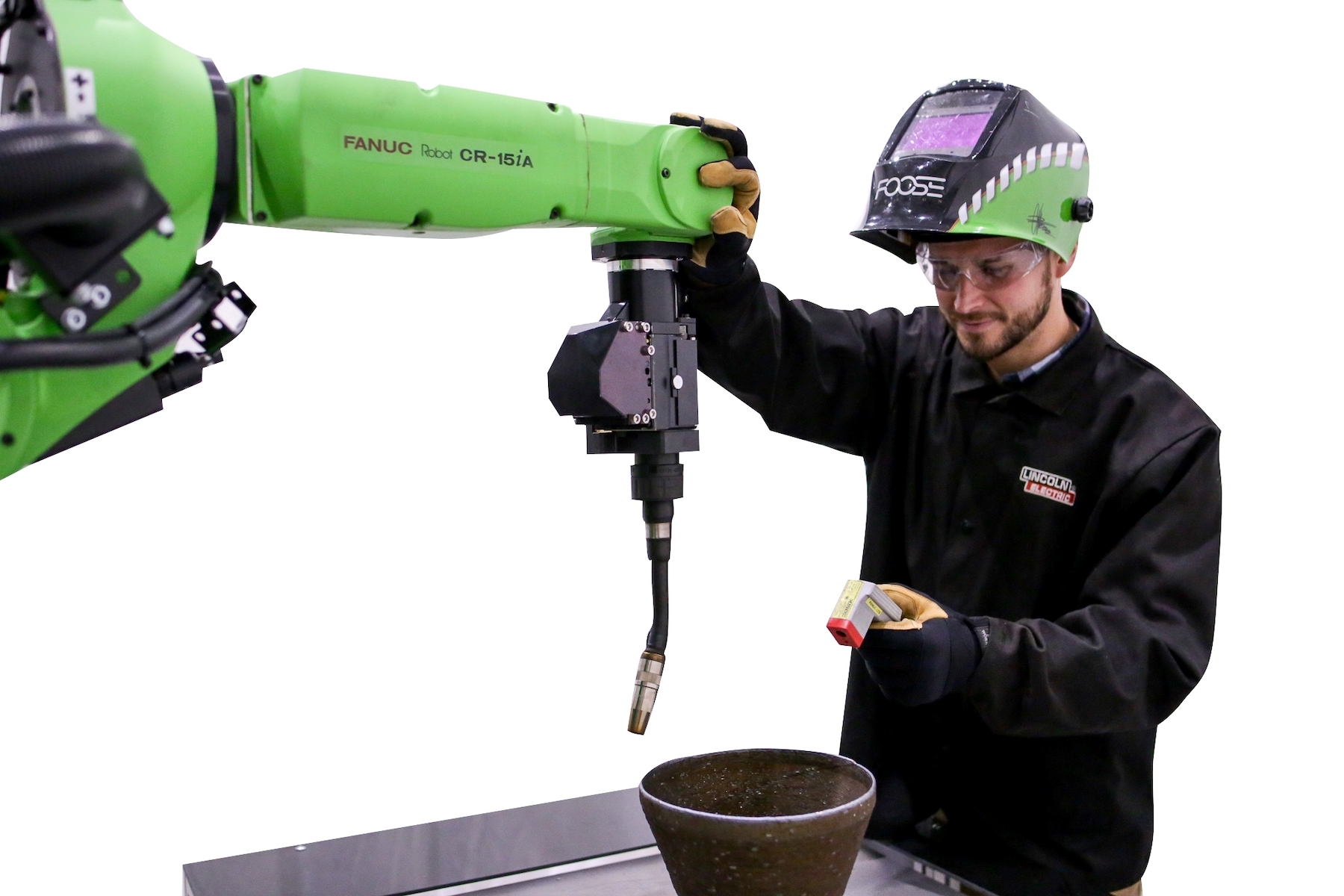
FANUC’s new ARC Mate welding cobots provide six axes of motion for maximum flexibility. The CR-15iA for ARC offers a 15kg payload and a 1441mm reach. This combination allows the processing of a broad range of parts and also can be used in newer applications, such as wire arc additive manufacturing.
Other cobots include the much smaller YuMi series from ABB. The single-arm YuMi is a compact, lightweight cobot that mounts in any direction for rapid, flexible installation into the production environment. Its seven axes mimic human-like movements with greater agility to meet the production needs of small parts assembly processes, like those encountered in consumer goods and consumer electronics manufacturing.
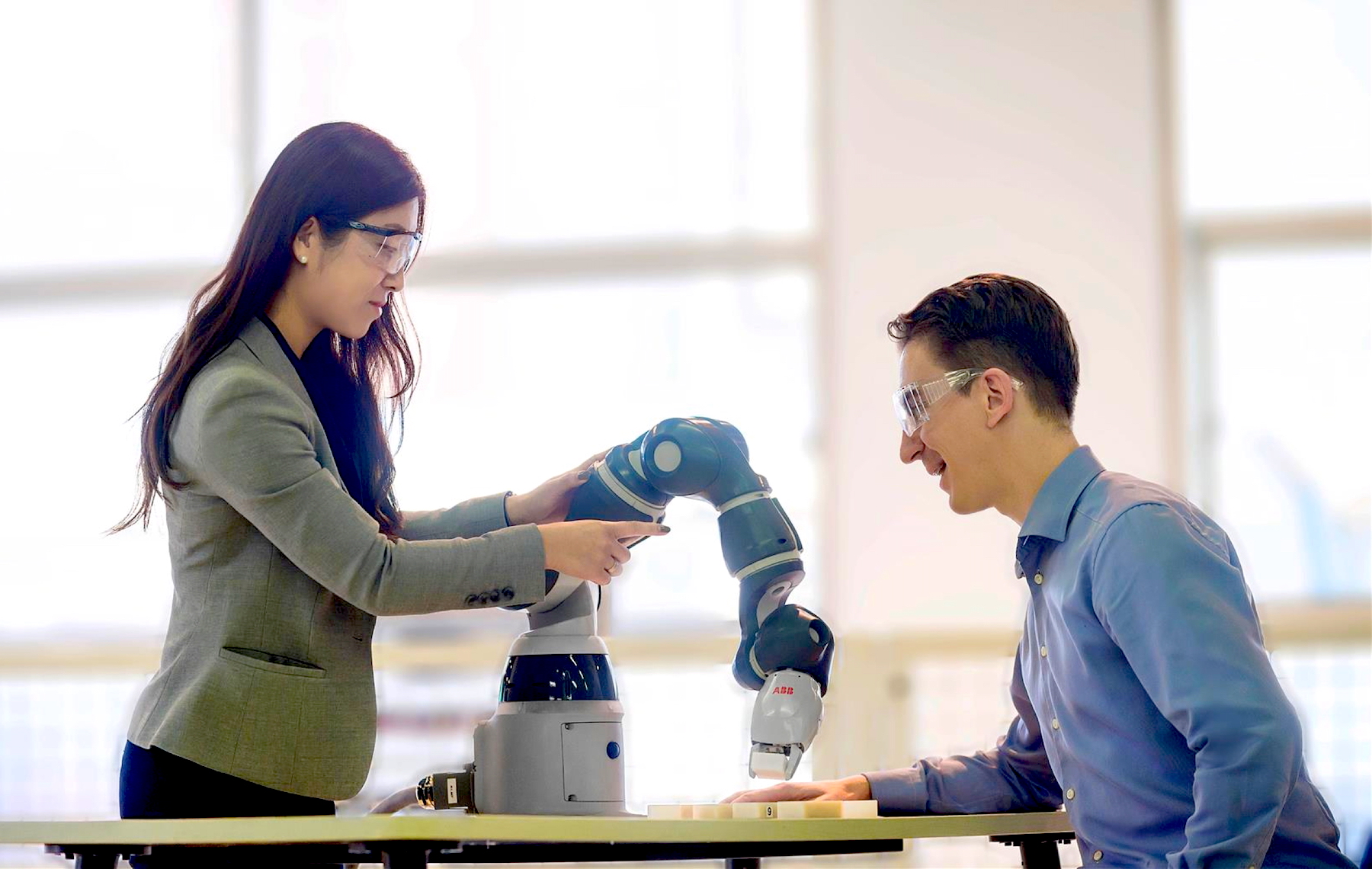
ABB’s compact, lightweight, single-arm YuMi cobot can be mounted in any direction, and its seven axes mimic human-like movements with greater agility. This allows it to meet the production needs of small parts assembly processes, such as in consumer goods and consumer electronics manufacturing.
Industrial robots and machinery are being connected to a much wider variety of devices in the IIoT network. This means that communication requirements between all these devices are also increasing, placing even more emphasis on the critical role played by connectors and cables in keeping the entire industrial network connected and operational.
Communication capabilities are thus becoming as important as power and signal interfaces, said Guenter Feldmeier, TE Fellow and global leader of standardization and consortia of TE Connectivity’s industrial business unit. That’s why Ethernet technology becomes very important: It’s used at different levels in industrial communication, such as the communication between the robot and its control cabinet, or between the cabinet and factory automation.
TE’s products for industrial and automation equipment address robots and industrial machinery, as well as motors, servo drives, and industrial communication, and include interconnects within the robots and other machines, as well as the external interfaces and all the connectivity between those devices. Sensors play a big role as well. “On one hand, this deals with power, signal, and communication, and on the other with the related interconnections, including hybrid types of interconnects,” said Feldmeier.
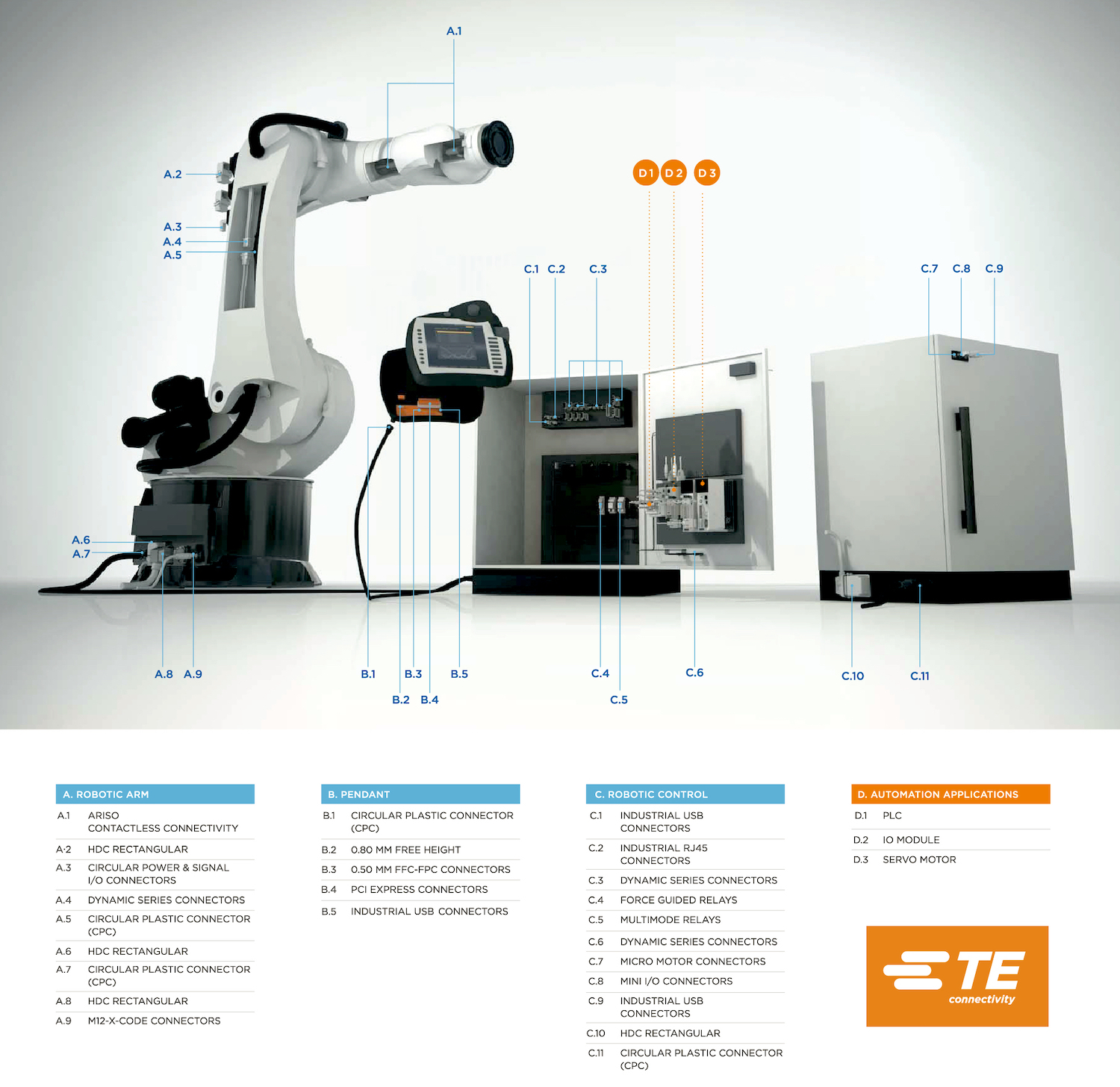
An industrial robot’s remote-control cabinet can be even more complex in terms of connectivity requirements than the robot itself. To ensure the robot’s fast and safe operation, a lot of communication is required between it and its control unit. Some of the connector and cable needs overlap.
Protected Versus Unprotected Connectors
Belden’s industrial data and connectivity communication connectors are designed for industrial factory automation communication protocols such as Industrial Ethernet and fieldbus, said Sylvia Feng, the company’s product line manager for industrial data and connectivity. “With the IIoT, more and more devices are utilizing Ethernet to communicate with one another on the industrial network,” she said.
Ethernet cables connect to different end-devices on the machinery, such as between programmable logic controllers (PLCs) and sensors, cameras, actuators, or anything else that utilizes data. Since the connectors are contained within an enclosure and already protected against harm, they don’t need to be sealed, so their protection level is IP20, said Feng.
The connectors employed in industrial robots and machinery are either unsealed connectors for protected conditions inside the box, which only need IP20-level protection, or sealed connectors for messy, harsh factory floor conditions outside of the box, which need IP67-level protection, said Feng. In both cases, these can be connectors for either power or communications.
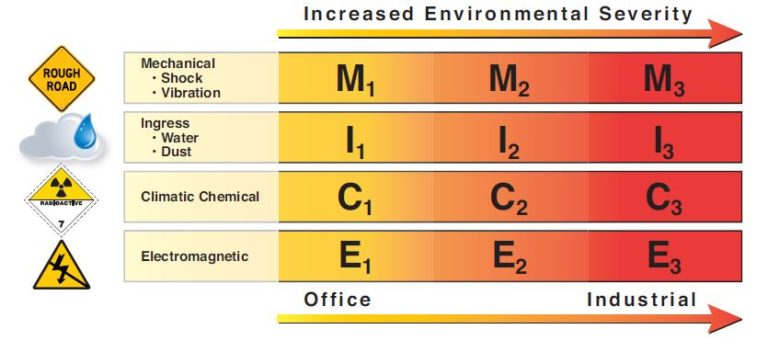
MICE parameters. Courtesy of Siemon.
The mechanical, ingress, climatic/chemical, and electromagnetic (MICE) classification system is one de facto industry standard for describing the different protection levels needed in the industrial environment. A clean, protected, carpeted office is a MICE 1 environment, a MICE 2 environment requires IP20-level protection, and a MICE 3 environment requires IP67 level protection.
“In MICE 1, you can use the cheapest, unshielded plastic connector, since it isn’t moved and doesn’t need to be ruggedized,” said Feng. “In MICE 3, there could be oil and other fluids splattering, temperature cycling, electromagnetic interference (EMI), or radio frequency interference (RFI), so you could need multiple types of protection.”
TE’s Feldmeier cited six overall system-level needs of industrial robots and machinery affecting interconnect requirements: miniaturization, reliability, ruggedness, flexibility, ease-of-use, and ease of installation. Miniaturization applies mainly to interconnection systems, for smaller sizes and increased packaging densities, while reliability needs relate primarily to vibration and physical shock up to 50g.
Ruggedness includes a very wide range of industrial operating temperatures, from -40°C up to +85°C. “The data side of the interconnection is especially sensitive to EMI, so TE provides full 360° solid metal shielding on our connectors for robots and other rugged applications,” said Feldmeier.
More Flexible Cabling and Connectors
Flexibility means several things in the industrial space. Cabling must be very physically flexible and support field installation, while field operators must terminate interconnects correctly, so connectors must be easy and quick to install. “10Gb/s Ethernet is very sensitive, so it must be supported by shielding to maintain electrical performance,” said Feldmeier. “But it must also be easy for workers to install the connectors with a minimum amount of instruction.”
The weakest link for network faults is at the ends of every Ethernet cable, where an RJ45 connector makes a connection with other devices, said Feng. Connection quality depends on connector quality and how well it was installed.
To make installation easy and consistent across different levels of installer experience, Belden developed the new DataTuff Industrial REVConnect RJ45 field-termination connectors. The new line offers connectors, cordsets, and accessories for Cat 5e, Cat 6, Cat 6a, UTP, and STP applications and, to solve the problem of fitting larger and bulkier industrial-grade connectors into tight spaces on the factory floor, includes right-angled, ruggedized metal-body R301606 DataTuff Industrial Ethernet RJ45 connectors for use in IP20 unsealed field-termination installations.
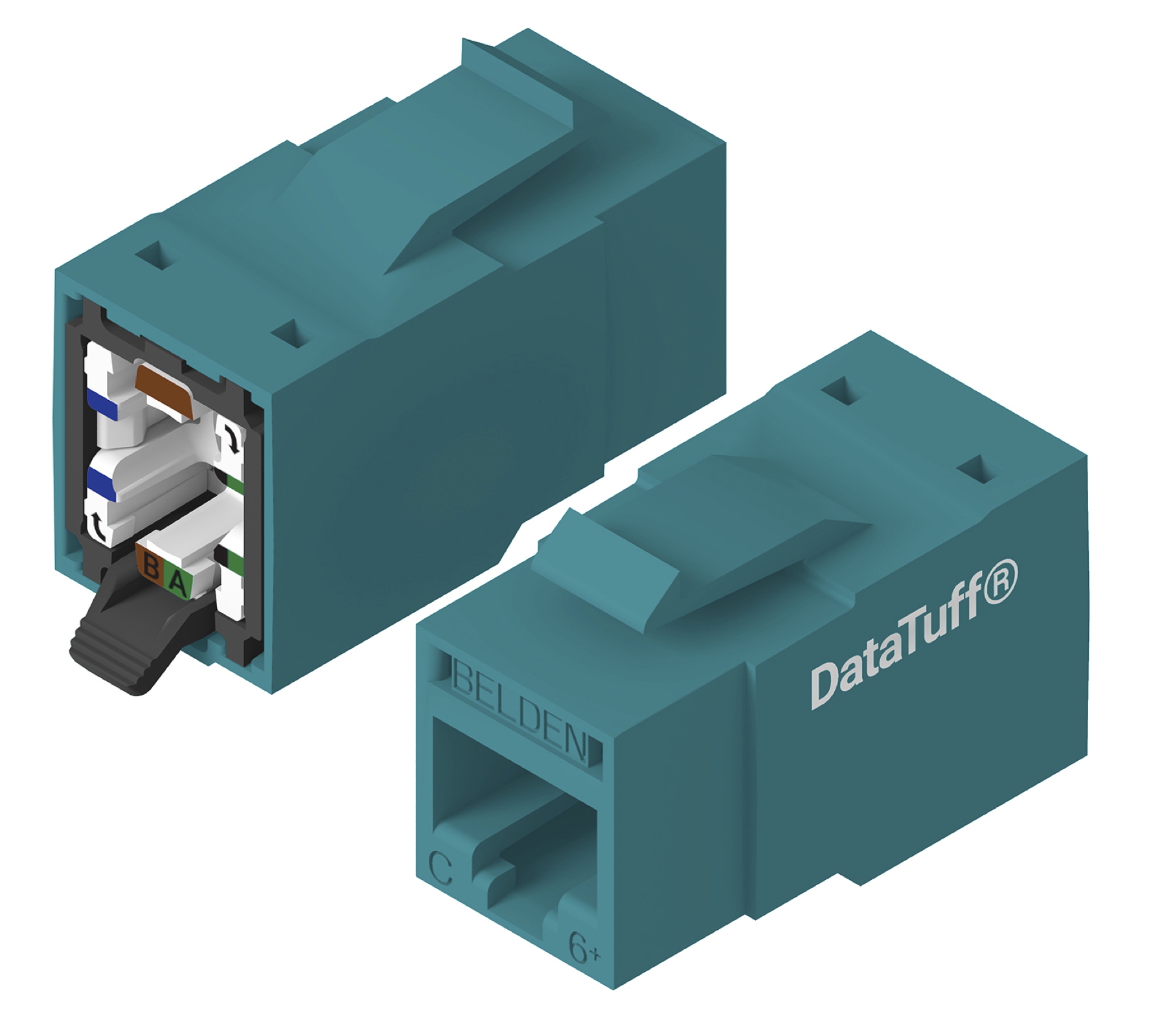
To make installation easy and consistent across different levels of installer experience, Belden developed the DataTuff Industrial REVConnect RJ45 field-termination connector, one of the simplest and fastest terminated connectors to install. The patented REVConnect design was applied originally in the IT space.
The company also offers single-pair Ethernet cable solutions and is researching and developing options for the whole system as well. Ethernet cable containing four twisted pairs inside makes a relatively large cable that can be used at lengths up to 100m. But Belden’s customers are asking for simpler, smaller cable that can communicate at 100Mb/s, or even up to 1Gb/s, to reduce cable cost and weight and allow robots to move more easily. “The small and simple design of single-pair Ethernet will be a huge help with connecting more devices to the industrial network,” said Feng.
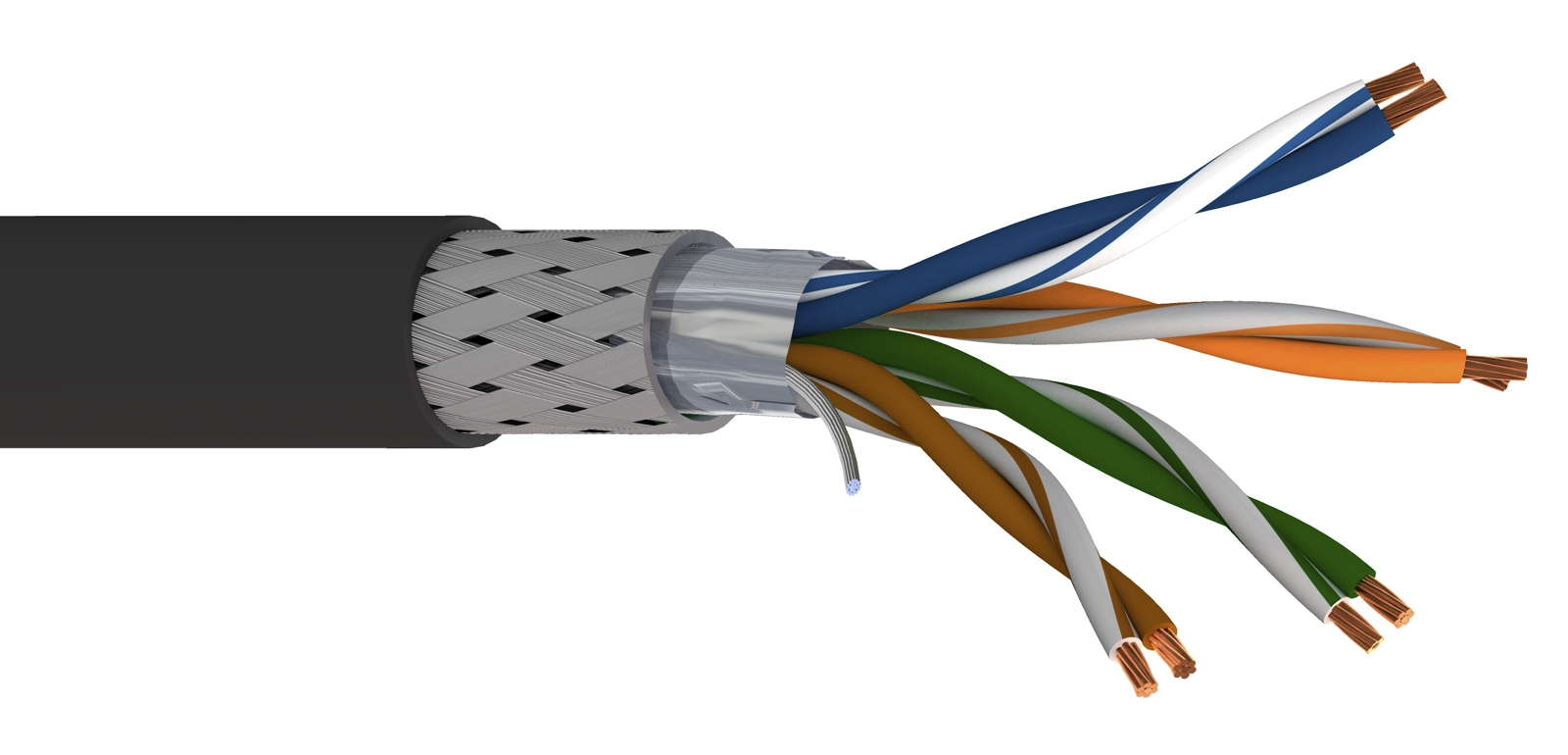
Belden has developed bonded-pair cable technology to improve the performance of Ethernet cable in high-availability environments. No matter how it’s installed, it keeps a cable’s twisted pairs together so impedance is always consistent. Mechanical strength is 60% higher and noise immunity is dramatically reduced.
Fischer Connectors recently added more connector size and material types to its low-profile, rugged, and durable LP360 connection systems that include connectors, cable assemblies, and active devices for industrial applications.
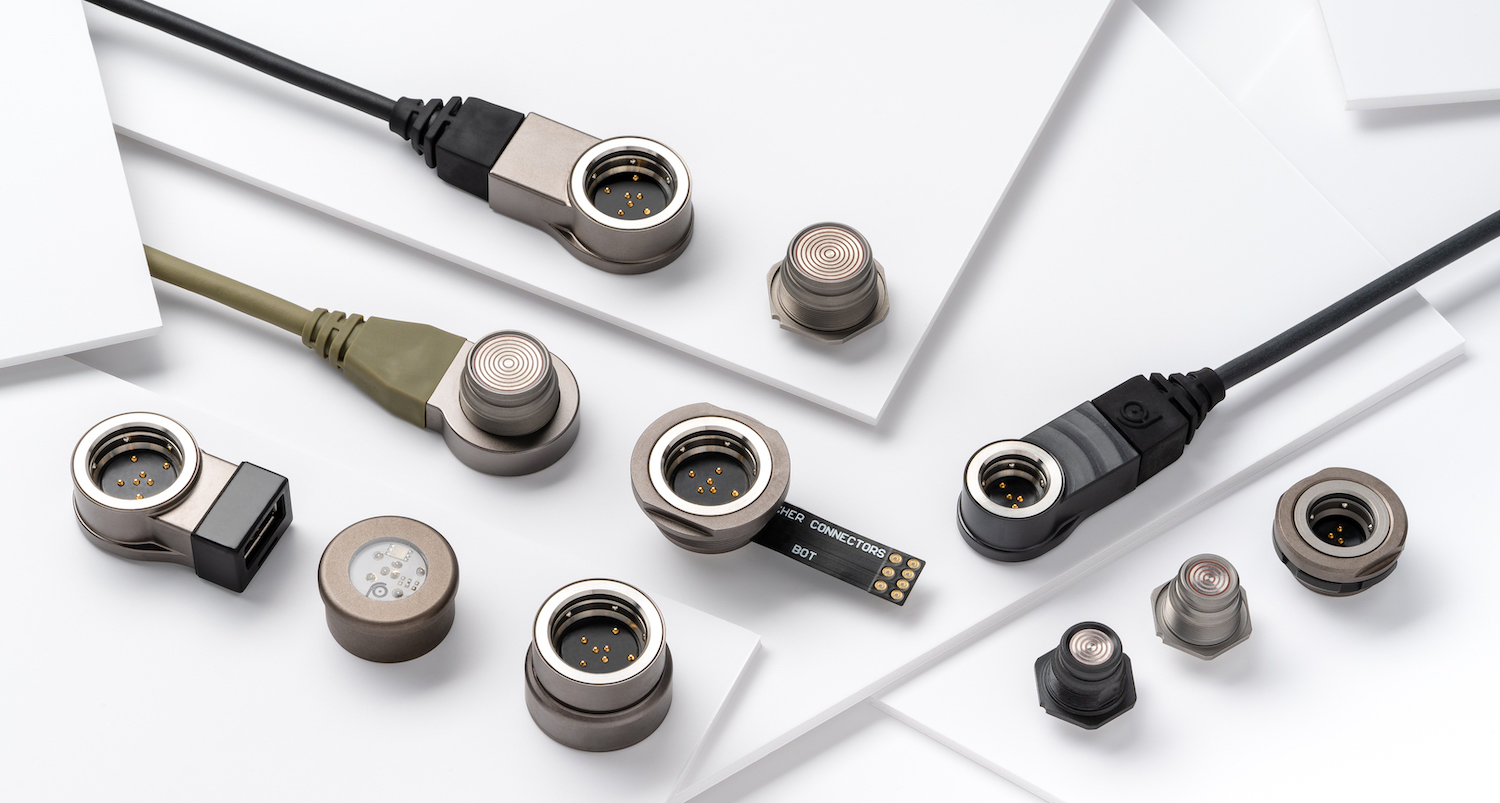
Fischer Freedom Series connector extensions
HARTING’s range of RJ Industrial Ethernet data interfaces includes the RJI MF RJ45 Cat 6A plug, an angled connector with IDC termination that offers IP20 protection from ingress. It is designed for cabling data networks in industrial applications in which data rates of up to 10Gb/s are required. Key factors are IP protection, plug-in reliability, robustness, vibration resistance, and EMC safety.
TE is also developing single-pair Ethernet products, which it sees as reflecting a near-future technology trend, said Feldmeier. The technology is already being integrated into new generations of automobiles, where it replaces CAN and other bus systems. “In the industrial space, it provides the infrastructure for the Industrial Internet of Things,” he said. “Our single-pair Ethernet M8 connector with additional power pins according to IEC 63171-6 is a new product in development for this purpose.”
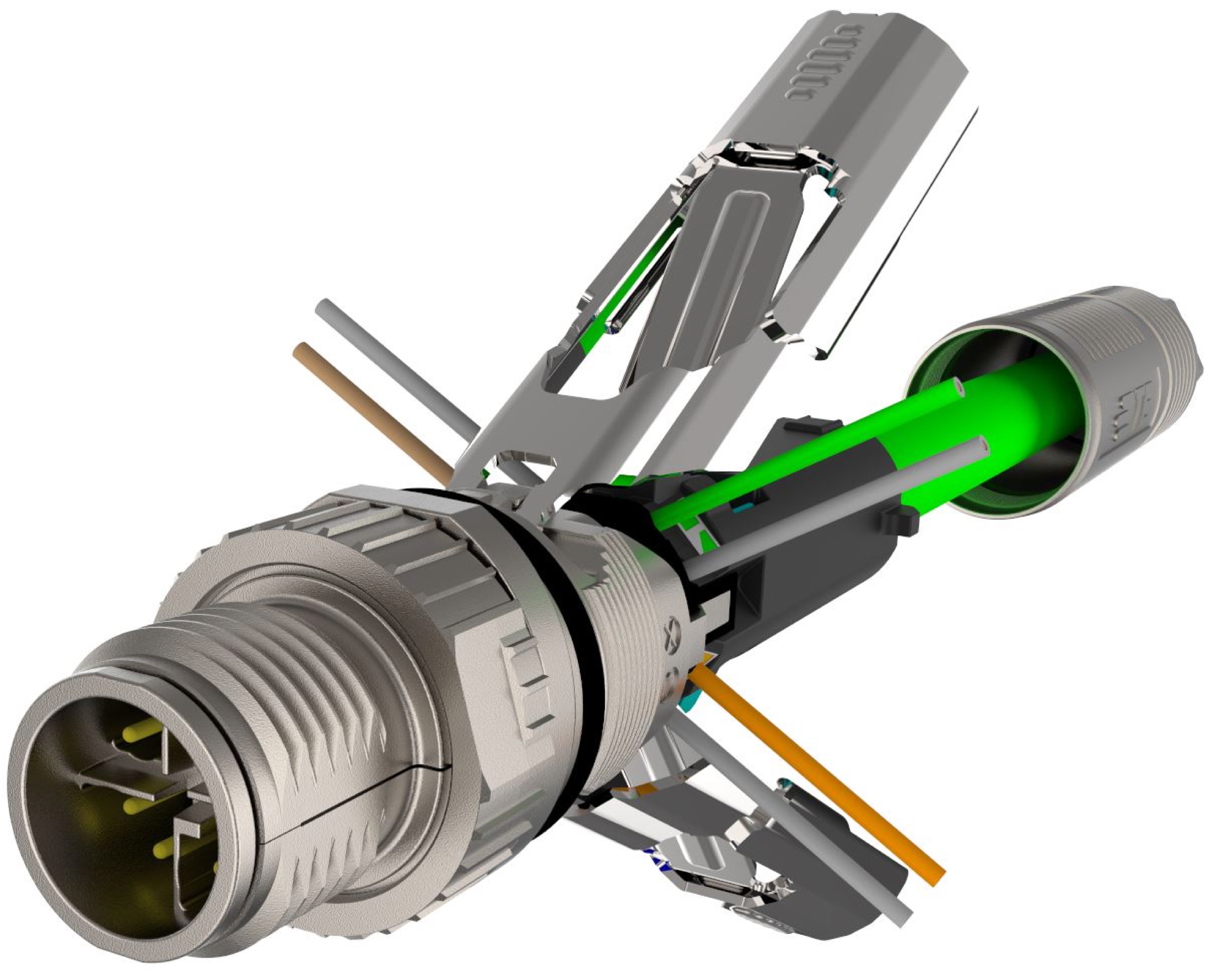
TE’s M12 X-coded connectors enable reliable communication in industrial equipment, are easy to install, support higher bandwidth needs of up to 10 Gbps, and provide IP67/68 levels of environmental protection.
Two TE products designed specifically for industrial robots and machinery with very small, very robust connections to enable the miniaturization of robots and other machines are TE’s M12 X-code and Mini I/O connector systems, which include connectors, cable assemblies, and I/O modules, support reliable communication up to 10Gb/s, and are available in field installable versions. Mini I/O has been adopted as an international standard by the IEC.
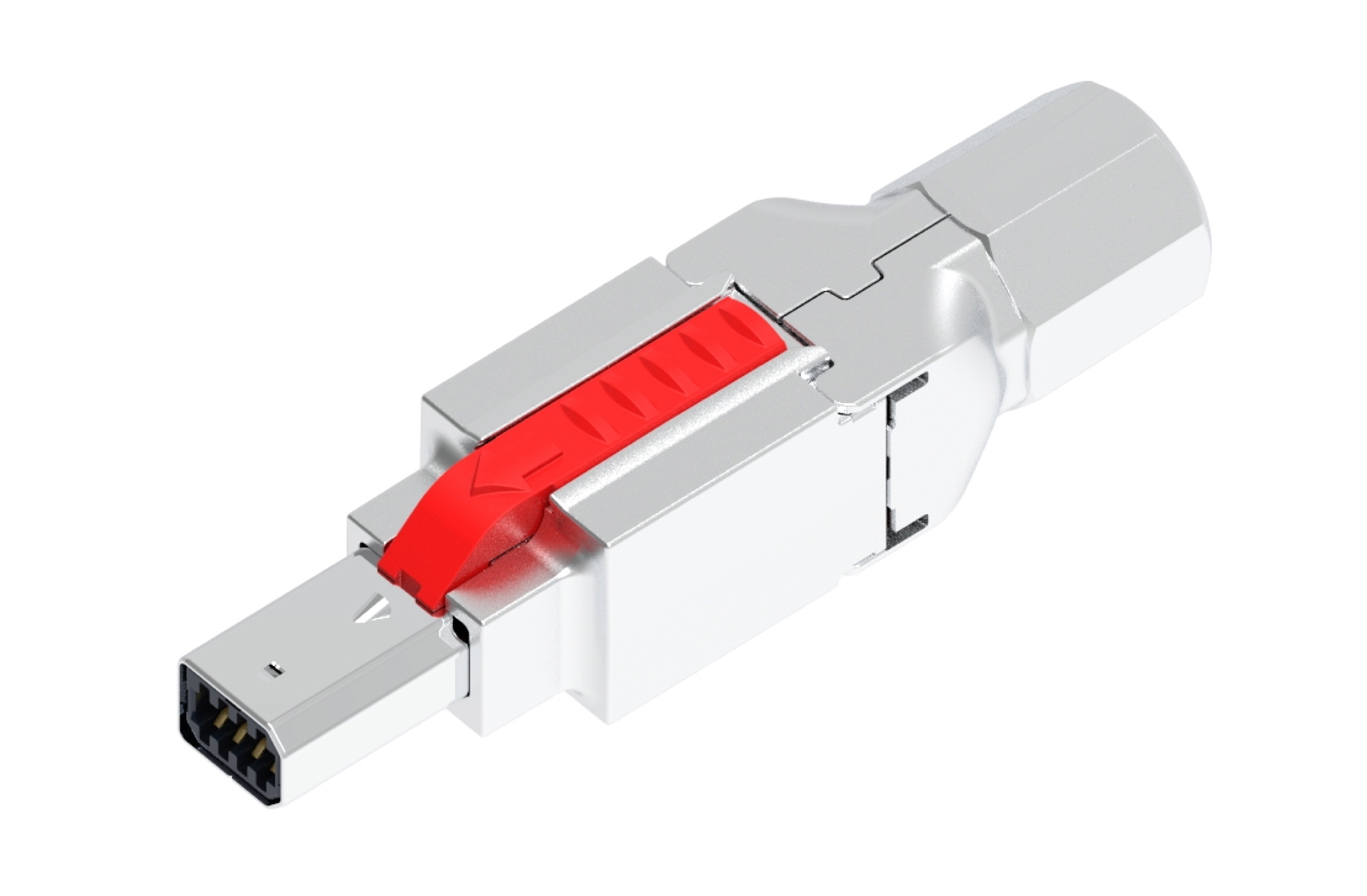
TE’s Mini I/O connector has been adopted as an international standard, IEC 61076-3-122, which provides the minimum requirements for a miniaturized connector for industrial applications.
Ann R. Thryft has been writing about manufacturing- and electronics-related technologies for 30 years, covering interconnect, single-board computers, robotics, machine vision, embedded devices, manufacturing materials and processes, and all kinds of datacom and telecom. She’s written for EE Times, Design News, COTS Journal, RTC Magazine, EDN, Test & Measurement World, and Nikkei Electronics Asia.
Like this article? Check out our other Connector and Cable Basics and Robotics articles, our Industrial and Datcom/Telecom Market Pages, and our 2020 and 2019 Article Archives.
- Underwater Connectors Get Smaller and Tougher for Submarines and UUVs - November 10, 2020
- Small Military UAVs Demand Smaller, Lighter Connectors - August 4, 2020
- Commercial Connectors Toughen Up for the Harshest Environments in the Universe - June 2, 2020
